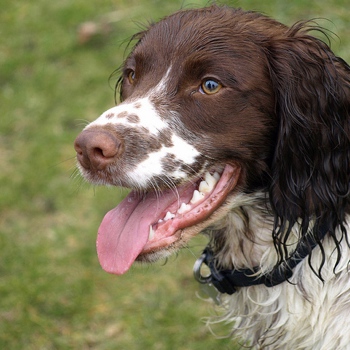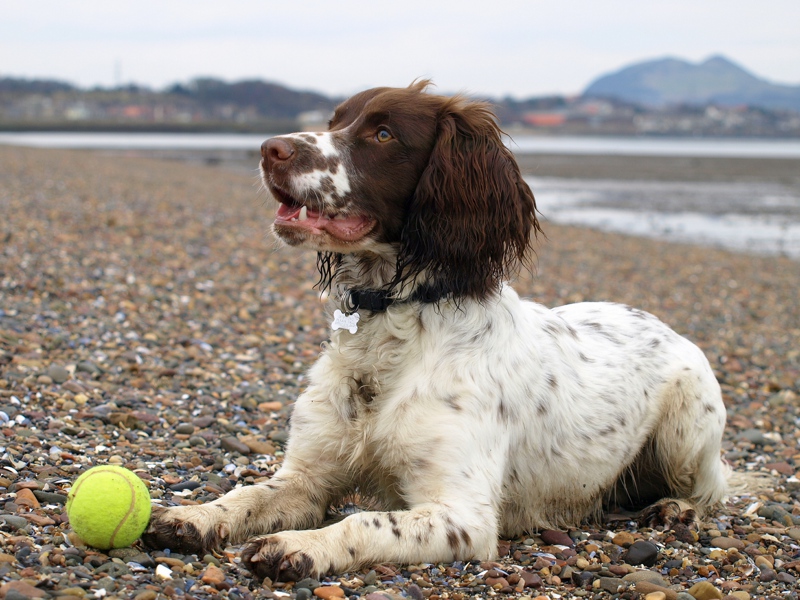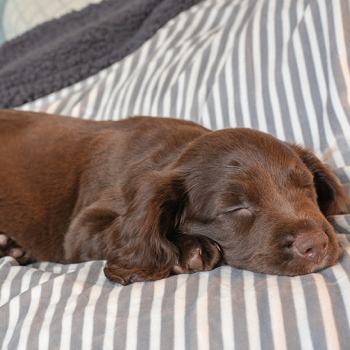Sprocker Spaniel

As the Springer Spaniel and Cocker Spaniel were the same breed not so long ago, in breeding them back together to create the Sprocker Spaniel, it would seem as though we have gone full circle! Known for their abundant energy, gentle souls and intelligence, it is no wonder that this newly-developed breed has grown quickly in popularity. Sprockers are a pleasure to train, as they live to please their master and have the brains to master a range of complex tasks.
A medium-sized dog, the Sprocker Spaniel has pendulous ears, expressive eyes and a glossy, crimped coat. Fur can come in an array of colours and patterns, with white and brown and white and black being two of the more popular colour combinations.
About & History
One of the better-known cross-breeds out there, the Sprocker Spaniel is a delightful combination of the closely related Cocker Spaniel and the English Springer Spaniel. As these two breeds used to be considered one and the same, there is less variation in this hybrid than most others. Though many will use the English Cocker Spaniel in the mix, it is also possible to use the American Cocker Spaniel, who shares many of the same genes.
Unsurprisingly, both the Cocker Spaniel and the Springer Spaniel share much of the same history. They were first intentionally bred together around 20 to 30 years ago, though it is likely that Cockers and Springers have mated prior to this, as many would have worked and lived together – though their offspring may not have been bred from in an attempt to retain the pedigree.
All Spaniels are thought to have once derived from Spain (hence the name). While they may have existed for a long time prior, it was not until the 14th century that the breed type was refined for the specific purpose of hunting. Traditionally used as gun dogs, Spaniels would be comfortable working on both land and water and were trained to flush and retrieve prey such as water fowl. A few hundred years later, these dogs were subdivided into what were known as ‘Crouching Spaniels’ and ‘Springing Spaniels’. Over time, the ‘Springing Spaniels’ were further classified into the smaller Cocker Spaniel and the taller Springer Spaniel.
In fact, it was during the latter half of the 19th century that these gun dogs were officially declared to be two separate breeds. Springers and Cockers are both kept as working dogs as well as pet and show dogs today, with individuals often looking quite different depending on what purpose they have been bred for. The American Cocker Spaniel is distinct from the English Cocker Spaniel, as it was refined in America during the 1900s to be smaller and lighter and has lost much of its athleticism and hunting abilities.
Appearance

The Sprocker Spaniel actually has quite a uniform appearance for a cross-breed as its parents closely resemble each other. Sprockers are notoriously handsome dogs with noble features and a well-proportioned body. Those bred from American Cockers will have a skull that is more dome-shaped. Their muzzle is relatively long and wide, ending in a remarkably sensitive nose that may be black or brown. Their jaws are strong and should meet in a perfect scissors bite. Their ears are one of their most endearing features, hanging sweetly beside their face, covered in shiny, wavy fur.
An athletically built dog, their bodies are muscular with well-sprung ribs. Though tail docking was once the norm, it is a trend that is now going out of fashion, even in working dogs. The tail of the Sprocker should be medium in length with a good plume of fur at the end. These dogs should move elegantly and quickly, exerting what seems like minimal effort to cover a good distance.
Measuring from 36cm to 51cm and weighing in at between 13.5kg and 20kg, the Sprocker is noticeably bigger than the more diminutive Cocker Spaniel and somewhat shorter and lighter than the Springer Spaniel. The long, wavy coat of the Sprocker Spaniel adds to their beauty and sophistication. They should have feathering on their ears, hind legs and tails. Coat can come in a wide variety of colours, including solid colours, such as black, red or fawn, roan markings in all colours, liver and white, black and white and tricolour.
Character & Temperament
A true advantage of the Sprocker Spaniel breed is that they have hearts of gold and are generally very affectionate, often fawningly so. They tend to adore their family and will bond closely with all of the family members, eager to be in their company whenever possible. They have gentle and docile natures and should do well with children that they have grown up with. Though bred to work, these dogs are just as content relaxing in the home as they are when in the field.
Sprockers are high energy and full of life – a trait which can be a real double-edged sword. While this makes them superb athletes and wonderful dogs to train, many dogs bought as pets will find that they are under-stimulated and under-exercised. This inevitably leads to frustration and behavioural problems. Sadly, breeds such as Sprocker Spaniels are over-represented when it comes to developing anxieties and destructive behaviours, such as chewing or barking, largely due to the fact that they are not being provided with the basic physical and mental stimulation that they require.
Trainability

Training a Sprocker can be wonderfully rewarding and there is no doubt that they have the ability to be trained to a high standard, excelling in disciplines such as agility, Flyball and canine dancing. Though they cannot compete in any official Gun Dog Tests or Field Trials (as they are not pedigree dogs), they can still participate for fun in similar activities organised outside Kennel Clubs and should be encouraged to do so.
Remarkably intelligent and keen to please their master, the Sprocker will try its best to obey commands and learn any new task asked of it. They benefit from a trainer who uses positive reinforcement techniques and consistent methods.
Health
The Sprocker Spaniel is very closely related to the Springer Spaniel and the Cocker Spaniel and will thus suffer from many of the same health issues as their parents.
Hip Dysplasia
Hip Dysplasia is a debilitating disease that negatively impacts an animal’s quality of life and can be especially devastating for a dog that was bred to work. As we now have effective screening tests that can diagnose hip dysplasia, it is strongly recommended that any parent to be bred from should be proven to be free from hip dysplasia.
Hypothyroidism
Dogs tend to develop hypothyroidism after the age of six and symptoms can include a generalised sluggishness, symmetrical alopecia, weight gain and a swollen face. Thankfully, the treatment for this condition is highly effective and, though animals will require lifelong medication, the prognosis is excellent.
Dilated Cardiomyopathy (DCM)
Both Springers and Cockers are known to inherit DCM, a heart disease that causes the heart to enlarge over time, reducing its ability to pump effectively and ultimately resulting in heart failure. Medicine known as ACE Inhibitors can help to slow the progression of this disease.
Ear Infections
Not surprisingly, the heavy, hanging ears of the Sprocker mean that many individuals will suffer from bouts of otitis externa throughout their life. Another issue, is that Spaniels tend to have hairs growing within the ear canal, which makes the environment warmer and prevents good airflow. Cocker Spaniels are especially prone to a nasty infection that is difficult to clear with a bacterium known as ‘Pseudomonas’, so it is likely that Sprockers may be too.
Due to this, it is advised that vets swab the ear when infected in order to assess the contents and determine which type of infection is present. If Pseudomans is detected, a prolonged course of strong antibiotics will be required and many will require their ears to be flushed under anaesthetic.
Exercise and Activity Levels
With an unparalleled zest for life and seemingly no ‘pause’ button, the Sprocker just loves to be active. They have high exercise requirements so would not be suited to those owners with a sedentary lifestyle. Ideally, they would live in a rural environment, such as on a farm. As well as several long walks or runs on the lead each day, they should be allowed to roam freely and explore at times, as long as it is safe to do so.
A dog that was made to work, the Sprocker needs to keep its mind active so will be most content if given tasks to do or if allowed to work or compete in canine activities. Puzzles, interactive dog toys and a variety of canine games are also recommended.
Grooming
The long, fine coat of the Sprocker should be brushed daily and owners should focus on those areas prone to matting, such as the armpits, groin, ears and tail. Many will bring their dog to a professional groomer a few times a year to keep their coat looking its best all year round. Owners should pay extra attention to the ears of their Sprocker, which are prone to infections and require regular cleaning.

